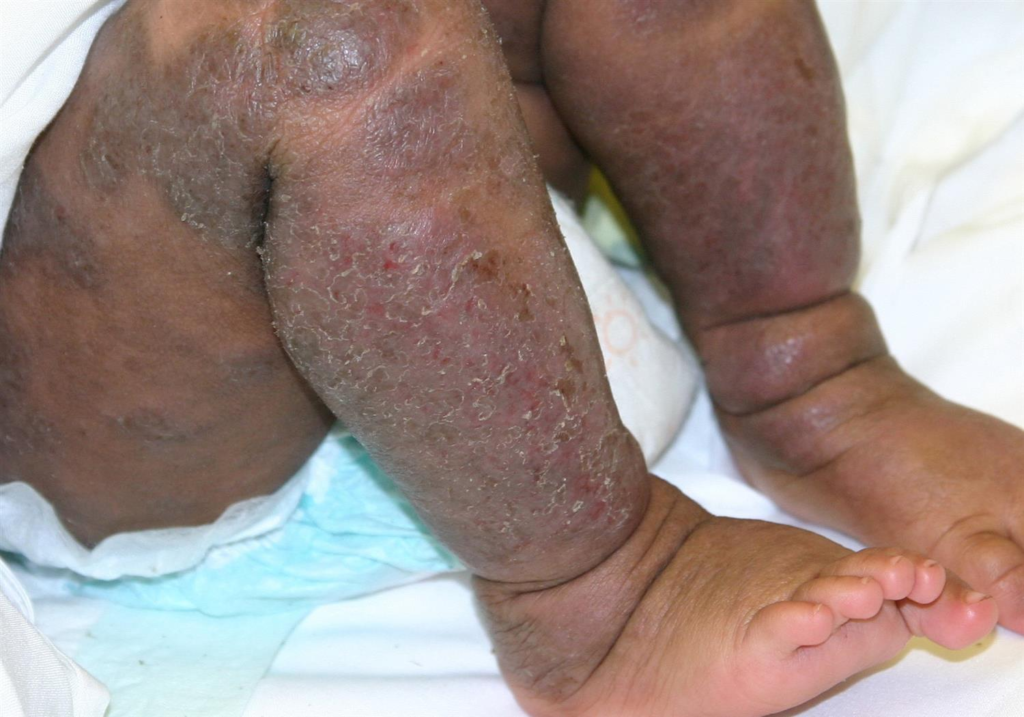Snapshot – Hyper IgE Syndrome

- A 3-year-old boy with a history of multiple infections presents with an intensely itchy rash. His skin is covered with an erythematous, crusty, scaly rash. Excoriations are seen where he scratched his skin. His face has thickened skin (coarse facies) and a wide-set nose. He has several abscesses without any pus formation over his arms. Labs come back with IgE levels of 3000 IU/mL.
Introduction

- Primary immunodeficiency syndrome from defect in neutrophil chemotaxis
- Also known as Job syndrome
- Also known as hyperimmunoglobulinemia E syndrome (HIES)
- Genetics
- Pathogenesis
- characterized by FATED
- coarse Facies
- cold staphylococcal Abscesses
- retained primary Teeth
- ↑ IgE
- Dermatologic problems
Presentation
- Symptoms
- recurrent colds
- Physical exam
- eczematous rash similar to atopic dermatitis
- papulopustular, crusted rash
- especially affects the face
- intensely pruritic
- skin infections
- noninflamed abscesses on body
- cool to touch
- retained primary teeth
- two rows of teeth
- eczematous rash similar to atopic dermatitis
- coarse facies
Evaluation
- ↑ IgE
- ↑ eosinophils
- ↓ IFN-γ
Differential
- Atopic dermatitis
- Wiskott-Aldrich syndrome
- SCID
Treatment
- Skin care for eczematoid dermatitis
- Prophylactic trimethoprim-sulfamethoxazole to prevent infections
- Antibiotics to treat infections
Prognosis, Prevention, and Complications
- Prognosis
- leading cause of death is infection
- average age of death 29 years
- leading cause of death is infection
- Complications
- ↑ risk of lymphoma
Hyper IgE Syndrome, also known as Job Syndrome, is a rare primary immunodeficiency disorder characterized by elevated levels of immunoglobulin E (IgE), recurrent bacterial infections, and distinctive clinical features. The syndrome is named after the biblical figure Job, who endured various afflictions. Understanding Hyper IgE Syndrome is essential for medical professionals, especially those in immunology, pediatrics, and infectious diseases. This article provides a comprehensive overview of Hyper IgE Syndrome, including its types, function, related studies, treatment considerations, and clinical significance.
Clinical Presentation:
- Characteristic Features: Patients with Hyper IgE Syndrome often display distinctive physical characteristics, such as coarse facial features, retained primary teeth, and fractures due to minimal trauma.
- Recurrent Infections: One of the hallmark features is recurrent bacterial infections, particularly of the skin, lungs, and sinuses. These infections can be severe and challenging to treat.
- Elevated IgE Levels: Hyper IgE Syndrome is characterized by extremely high levels of IgE antibodies in the blood.
Function and Genetic Basis:
Hyper IgE Syndrome is primarily caused by mutations in the STAT3 gene, affecting the Signal Transducer and Activator of Transcription 3 protein. This protein is critical for the regulation of immune responses and inflammatory processes.
Types of Hyper IgE Syndrome:
- Autosomal Dominant Hyper IgE Syndrome (AD-HIES): This form is caused by heterozygous mutations in the STAT3 gene. AD-HIES typically presents with the classic features of the syndrome.
- Autosomal Recessive Hyper IgE Syndrome (AR-HIES): AR-HIES is rare and caused by biallelic mutations in genes other than STAT3. It may have similar features to AD-HIES but can also present with additional complications.
Diagnosis and Studies:
- Clinical Evaluation: Diagnosis involves clinical assessment of characteristic features, elevated IgE levels, and recurrent infections.
- Genetic Testing: Genetic testing identifies mutations in the STAT3 gene for AD-HIES and other relevant genes for AR-HIES.
Clinical Significance:
- Immunodeficiency: Hyper IgE Syndrome impairs immune responses against bacterial infections, leading to recurrent and severe infections.
- Inflammatory Dysfunction: Dysregulation of the immune system’s inflammatory responses contributes to the distinct clinical features of the syndrome.
Treatment Considerations:
- Infection Management: Treatment focuses on managing recurrent infections with appropriate antibiotics and other antimicrobial agents.
- Prophylactic Measures: Prophylactic antibiotics or antifungal medications may be considered to prevent infections.
Future Directions:
- Targeted Therapies: Research explores targeted therapies that modulate immune responses and inflammatory processes in Hyper IgE Syndrome.
- Genetic Therapies: Advances in genetic therapies may offer precision treatments that address the underlying genetic defects.
Conclusion:
Hyper IgE Syndrome, also known as Job Syndrome, is a rare primary immunodeficiency disorder characterized by elevated IgE levels, recurrent bacterial infections, and distinctive clinical features. It is primarily caused by mutations in the STAT3 gene, affecting immune responses and inflammatory processes. Hyper IgE Syndrome can be classified into autosomal dominant and autosomal recessive forms. Diagnosis involves clinical evaluation and genetic testing.
Treatment focuses on managing infections and, in severe cases, considering prophylactic measures. Research explores targeted therapies and genetic interventions to address the underlying immunodeficiency and inflammatory dysfunction. Medical professionals need a comprehensive understanding of Hyper IgE Syndrome to accurately diagnose, manage affected individuals, and contribute to ongoing research efforts aimed at advancing treatment options for this complex disorder.
Check out USMLE Success Strategy: Personalized Consultation and Study Plan Development.



